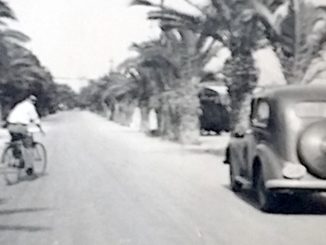
London Bridge, London,
London Bridge, London – Public domain
Beneath the headline London’s Joyous Welcome to the New Year, the Daily Mirror of 1st January 1925 showed a ‘special Daily Mirror photograph’ snapped as revellers welcomed in the New Year at the Albert Hall. Pretty girls flung gaily coloured balloons. Partygoers clustered around a monster cake in the centre of the hall. Miss 1925 made a triumphal entry on the stroke of midnight.
At the bottom half of the page were pictures of the great and the good who had been mentioned in the New Year’s Honours List. Sir Henry Duke, President of the Divorce Division, received a barony. Mr H. C. O. Bonsor was created a baronet. Mrs Millicent Garrett and Miss Ellen Terry received GBEs. Out of those, you may have heard of actress Ellen Terry, but I’ll bet a weathered Queen Victoria brass farthing to a shiny new King George V gold guinea that – like this reviewer of old newspapers – you haven’t heard of a GBE.
The Knight Grand Cross or Dame Grand Cross was the highest grade of the five classes of King George’s Most Excellent Order of the British Empire. Although not as common as CBEs, OBEs, and MBEs, there is still such a thing today. The two most recent appointees in 2025 were novelist Dame Jacqueline Wilson GBE FRSL and immunologist and academic administrator Sir Leszek Borysiewicz GBE DL FRS FRCP FMedSci FLSW.
As for the inside front page, as proof that not much changes, the newsy headline was about the weather, with the text below telling readers what they already knew. Nineteen twenty-four had come to a dreary and dismal end, passing with a mixture of gales, floods, rain, frost, snow, thunder, a slight earthquake shock in East Lancashire, and a sort of sudden fifty-miles-an-hour tornado in London.
A fitting end to a turbulent and difficult year.
On the other side of the Atlantic, the Roaring Twenties (the Wall Street Crash wasn’t until 1929) were in full swing. The decade was being defined by economic prosperity, cultural dynamism, and significant social changes.
The Jazz Age was thriving. Cities like New York and Chicago pulsated with the sounds of such music, the glamour of speakeasies, and the rebellious energy of the flapper generation. Prohibition was still in effect, driving the liquor trade underground and increasing the influence of organised crime and figures such as Al Capone.
Advances in medicine and physics were also reshaping the intellectual landscape, with figures like Albert Einstein and Niels Bohr leading revolutionary changes in theoretical physics. Culture and entertainment flourished. The silent film era was at its peak, with stars like Charlie Chaplin captivating global audiences. Literature was also experiencing a golden age, with authors such as F. Scott Fitzgerald and Ernest Hemingway defining the voice of a restless generation.
Internationally, political tensions and transformations were brewing. In Europe, nations were still adjusting to the post-war order established by the Treaty of Versailles. The Weimar Republic in Germany grappled with economic challenges and political instability, while France and Britain attempted to maintain their influence on the global stage.
In the Soviet Union, Joseph Stalin was beginning to solidify his grip on power after 53-year-old Lenin had fallen into a coma and died in Gorki in the January. Stalin’s rivals such as Leon Trotsky had been edged out of the political arena.
Meanwhile, in Blighty, after the post-Great War boom of 1919–20, unemployment rose sharply to over 10% and stayed high until the Second World War.
Also in January 1924, Ramsay MacDonald formed the first-ever Labour government, albeit in a minority, after Conservative Prime Minister Stanley Baldwin lost a House of Commons confidence vote.
One of the first acts of Mr MacDonald’s government was to grant de jure recognition to the Soviet government. An Anglo-Soviet conference opened on 14th April 1924 to settle outstanding political questions arising from the Russian Revolution seven years earlier, and to negotiate a commercial treaty. It proved difficult to arrive at an agreement, especially regarding the settlement of Britain’s financial claims and the cessation of Bolshevik propaganda, upon which depended a British loan to Russia. On 5th August, it was announced that the negotiations had broken down.
Nonetheless, and to general astonishment, Mr MacDonald and Mr Arthur Ponsonby, Under-Secretary of State for Foreign Affairs, signed a general treaty all the same, along with a Treaty of Commerce and Navigation with the Soviet representatives.
As per a century later, 1924 was an election year that saw a dramatic change of government. Mr MacDonald played the part of the hapless Rishi Sunak. As the minority government struggled, MacDonald called an election for 29th October.
Remaining with Russia, the Zinoviev letter — a forged document sensationalised by the Daily Mail — was published four days before the vote. The letter claimed to be a directive from the head of the Communist International in Moscow to the Communist Party of Great Britain (CPGB). In it, the CPGB was ordered to pursue a Bolshevik-style revolution in Britain aided by the normalisation of British–Soviet relations under the Labour treaty.
Labour members blamed the publicity, at least in part, for their defeat in October, after which a new parliament formed with a Conservative majority of 209. This parliament refused to ratify the MacDonald/Ponsonby treaties.
The House of Commons now consisted of 415 Conservatives and Unionists, 153 Labour members, and only 43 Liberals — down from 158. Essentially the end of the Liberal Party as a party of power, the debacle even saw the party’s leader and former Prime Minister Herbert Asquith lose his Paisley seat.
Further afield, the border between Iraq and Turkey was disputed, with a conference taking place to address the issue in Istanbul, still then known as Constantinople, on 19th May, then still known as Constantinople. No agreement was reached, and on 5th June the dispute was passed on to the Council of the League of Nations in Geneva. They recommended that the status quo should be maintained. Turkish troops remained in the disputed territory, as per the Turkish interpretation of the status quo. However, towards the end of October, the British case was put before the League by Lord Parmoor, as a result of which Turkish troops were withdrawn.
An important point arises regarding today’s crisis concerning the movement of people and the resulting impact upon these shores from both legal and illegal immigration. The population of Iraq in 1924 was only 3 million. Now it is 46 million. As for Turkey, in a century, the population has risen by 72 million, from 13 million to 85 million.
The disputed territory was Mosul, which Britain oversaw through its post-WWI mandate over Iraq. In 1924, Turkey claimed the partly Kurdish-populated province. A century later, Mosul remains part of Iraq, although it had to be recaptured from Islamic State in 2017 following a barbaric occupation that would make an Ottoman Sultan blush. A Kurdish semi-autonomous federal region now lies further to the north of Iraq, with its capital at Erbil.
As further proof that not much changes, a century on from the Constantinople conference and following the recent fall of President Assad, Turkish forces now occupy territory to the south of their border further to the west of the Levant in Sryia.
In happier news, the 1924 Budget took place on 29th May. Chancellor Philip Snowden announced national revenue for the previous year of £837m, against the estimate of £818m. Expenditure reached £788m, well shy of the anticipated £816m. In other words, the government was making a profit. Mr Snowden went on to announce the paying off of government debt and a reduction in some taxes and duties. Dare we hope for more of the same one hundred years on!?
Happy New Year.
© Always Worth Saying 2025



